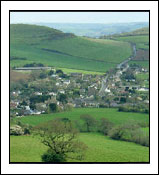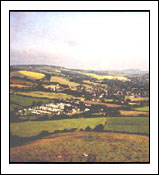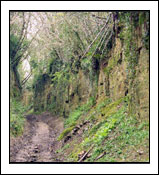 |

Chideock, West Dorset. England
The connection:
As we continue to research the Chittick name and the genealogical
mysteries behind it all, we keep coming to one recurrent fact.
The line of Chittick's that most of us originated from came
from England with the name Chideock. That is not to say that
another line that we have not found yet, could validate another
story.

Chideock, England
|
The farthest back we can trace our lineage is back to the 1600's,
when a Henry Chideock (descendant from Henry VII) moved from
Chideock, England, to Fermanagh County, Ireland.
It has been documented that Henry Chideock started spelling
his name Chittick, because that is way the locals pronounced
the name in Fermanagh.
His father was John Chideock, who marriend Elizabeth Robertson,
and his father was Thomas Chideock, who married Elizabeth Stanley
(whose mother, was Lady Margaret Clifford, great-grand daughter
of Henry VII).
We (part of the america side) descend directly from Fermanagh
County, Ireland in the mid-1800's, and chitticks live there
today.
View the descendancy chart from Henry VII to Fermanagh Chideocks,
and eventually Chitticks:
Read the Chideock/Chittick History:

Another view of Chideock
|
Tell me about it:
Founded in 1086, most of the cottages in Chideock are on
the main road, but there are some tucked back along the lane
to Seatown. The turning to Seatown is on the left if you are
travelling west, just as the road starts to climb uphill,
exactly opposite the parish church of St Giles. This is the
only turning to Seatown, so if you miss it you will have to
turn around. North Chideock is a string of plesant cottages
and bungalows along the lane next to the Church. North Chideock
enjoys the peace and quiet of being set back from the main
road. North Chideock makes an ideal base for one of many walks
that can be had from here. There are an enormous amount of
footpaths in the parish.

Chideock Castle Remains
|
To the east end of the village on the North side of the main
road is Ruins Lane, a short track which leads you up to ruins
field, where you will see the site of Chideock castle. All
that remains now is the moat and a large cross, erected in
memory of the Chideock Martyrs. The
castle was built in 1380 by John de Chideocke. The castle
was supplied with running water from a spring in Quarry Hill,
via lead piping. This helped the castle to withstand seige.
During the English Civil War, the castle stood as a royalist
stronghold, and was attacked several times by the parliamentaries,
who finally succeeded in 1645 and captured it. In the last
battle a cannon was positioned it is said, either on top of
the church tower, or in the church yard and that the church
was damaged by return fire. The castle was destroyed and the
villagers used much of the stone to build their cottages.
During the 1500s and 1600s the lords of the manor were a Catholic
family who held mass within the castles, along with many villagers,
who were also catholic. This was risky, because the law at
the time forbade Catholics to worship. During this period
7 or 8 men from the village were caught participating in these
services and were killed in awful torturous deaths. I do not
know why it is that there are only officially five Chideock
Martyrs, because there were certainly more than five. The
martyrs were tried in Chideock House, which is now the Chideock
House Hotel in the main street. The cross in ruins field is
a memorial to these men.
Read about the Chideock Martyrs,
and their tragic story:
Read about the history of Chideock, for over 900 years:
CIDIHOC, as it was called in the Domesday Book for 1086
is, 900 years later today’s Dorset Village of Chideock,
though the name has enjoyed many spellings over the past centuries
as well as in early Saxon Times.
Prior to the Norman Conquest, it had belonged to King Alfred
but was seized by William the Conqueror within two years of
the Conquest. The Manor was subsequently granted to Norman Barons,
but in 1312 Edward II transferred the lands of CHIDIOCK to the
first John De Chidiock whose family came from Bridport.
In 1449 they passed through marriage, to the Arundell family
who held them until purchased in 1802 by Thomas Weld, whose
grandson subsequently married a descendant of the last Sir John
De Chidiock. The Welds lived in the present Manor House until
recently, so only three families have held the tenure of the
Manor of Chideock for over 650 years.
Chideock, West Dorset Official Web site:
Chideock, Photo Gallery:
|






|



